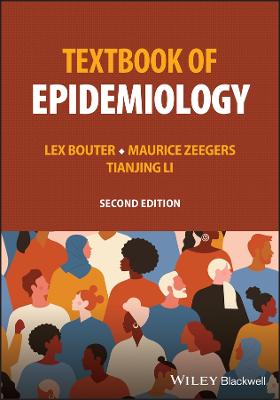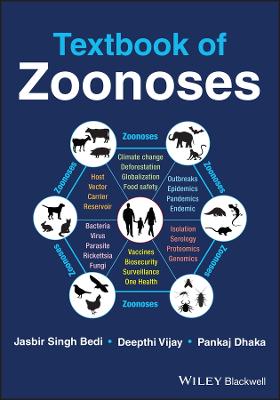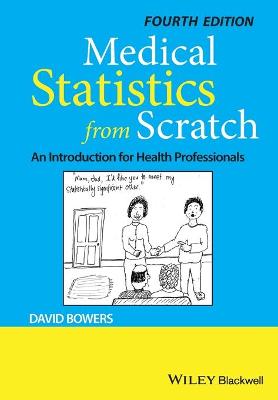Statistical Analysis of Doubly Truncated Data
 -15%
portes grátis
-15%
portes grátis
Statistical Analysis of Doubly Truncated Data
With Applications in R
Moreira, Prof Carla; Crujeiras, Rosa M.; de Una-Alvarez, Jacobo
John Wiley & Sons Inc
12/2021
192
Dura
Inglês
9781119951377
15 a 20 dias
410
Descrição não disponível.
Preface xi
List of Abbreviations xiii
Notation xv
1 Introduction 1
1.1 Random Truncation 1
1.2 One-sided Truncation 2
1.2.1 Left-truncation 2
1.2.2 Right-truncation 2
1.2.3 Truncation vs. Censoring 3
1.3 Double Truncation 3
1.4 Real Data Examples 5
1.4.1 Childhood Cancer Data 5
1.4.2 AIDS Blood Transfusion Data 6
1.4.3 Equipment-S Rounded Failure Time Data 7
1.4.4 Quasar Data 7
1.4.5 Parkinson's Disease Data 8
1.4.6 Acute Coronary Syndrome Data 9
References 10
2 One-Sample Problems 13
2.1 Nonparametric Estimation of a Distribution Function 13
2.1.1 The NPMLE 14
2.1.2 Numerical Algorithms for Computing the NPMLE 21
2.1.3 Theoretical Properties of the NPMLE 24
2.1.4 Standard Errors and Confidence Limits 36
2.2 Semiparametric and Parametric Approaches 43
2.2.1 Semiparametric Approach 44
2.2.2 Parametric Approach 52
2.3 R Code for the Examples 56
2.3.1 Code for Example 2.1.8 56
2.3.2 Code for Examples 2.1.11 and 2.1.13 56
2.3.3 Code for Example 2.1.14 58
2.3.4 Code for Example 2.1.15 59
2.3.5 Code for Example 2.1.22 60
2.3.6 Code for Example 2.2.6 61
2.3.7 Code for Example 2.2.8 62
References 65
3 Smoothing Methods 69
3.1 Some Background in Kernel Estimation 69
3.2 Estimating the Density Function 71
3.3 Asymptotic Properties 71
3.4 Data-driven Bandwidth Selection 77
3.4.1 Normal Reference Bandwidth Selection 78
3.4.2 Plug-in Bandwidth Selection 79
3.4.3 Least-squares Cross-validation Bandwidth Selection 80
3.4.4 Smoothed Bootstrap Bandwidth Selection 81
3.4.5 Bandwidth Selectors in Practice 82
3.5 Further Issues in Kernel Density Estimation 88
3.6 Estimating the Hazard Function 90
3.7 R Code for the Examples 98
3.7.1 Code for Example 3.2.1 98
3.7.2 Code for Examples 3.3.4 and 3.3.5 99
3.7.3 Code for Examples 3.4.2 and 3.4.3 100
3.7.4 Code for Example 3.5.1 102
3.7.5 Code for Example 3.6.4 104
3.7.6 Code for Example 3.6.5 105
References 106
4 Regression Analysis 109
4.1 Observational Bias in Regression 109
4.2 Proportional Hazards Regression 114
4.3 Accelerated Failure Time Regression 117
4.4 Nonparametric Regression 121
4.5 R Code for the Examples 126
4.5.1 Code for Example 4.1.1 126
4.5.2 Code for Example 4.1.4 126
4.5.3 Code for Example 4.2.4 127
4.5.4 Code for Example 4.3.2 127
4.5.5 Code for Example 4.4.2 128
References 129
5 Further Topics 131
5.1 Two-Sample Problems 132
5.2 Competing Risks 137
5.2.1 Cumulative Incidences 139
5.2.2 Regression Models for Competing Risks 142
5.3 Testing for Quasi-independence 146
5.4 Dependent Truncation 150
5.5 R Code for the Examples 157
5.5.1 Code for Example 5.1.3 157
5.5.2 Code for Example 5.2.4 159
5.5.3 Code for Example 5.2.6 160
5.5.4 Code for Example 5.3.1 161
5.5.5 Code for Example 5.4.3 161
References 162
A Packages and Functions in R 165
A.1 Computing the NPMLE and Standard Errors 166
A.2 Assessing the Existence and Uniqueness of the NPMLE 167
A.3 Semiparametric and Parametric Estimation 168
A.4 Kernel Estimation 168
A.5 Regression Analysis 169
A.6 Competing Risks 169
A.7 Simulating Data 170
A.8 Testing Quasi-independence 170
A.9 Dependent Truncation 170
References 171
Index 173
List of Abbreviations xiii
Notation xv
1 Introduction 1
1.1 Random Truncation 1
1.2 One-sided Truncation 2
1.2.1 Left-truncation 2
1.2.2 Right-truncation 2
1.2.3 Truncation vs. Censoring 3
1.3 Double Truncation 3
1.4 Real Data Examples 5
1.4.1 Childhood Cancer Data 5
1.4.2 AIDS Blood Transfusion Data 6
1.4.3 Equipment-S Rounded Failure Time Data 7
1.4.4 Quasar Data 7
1.4.5 Parkinson's Disease Data 8
1.4.6 Acute Coronary Syndrome Data 9
References 10
2 One-Sample Problems 13
2.1 Nonparametric Estimation of a Distribution Function 13
2.1.1 The NPMLE 14
2.1.2 Numerical Algorithms for Computing the NPMLE 21
2.1.3 Theoretical Properties of the NPMLE 24
2.1.4 Standard Errors and Confidence Limits 36
2.2 Semiparametric and Parametric Approaches 43
2.2.1 Semiparametric Approach 44
2.2.2 Parametric Approach 52
2.3 R Code for the Examples 56
2.3.1 Code for Example 2.1.8 56
2.3.2 Code for Examples 2.1.11 and 2.1.13 56
2.3.3 Code for Example 2.1.14 58
2.3.4 Code for Example 2.1.15 59
2.3.5 Code for Example 2.1.22 60
2.3.6 Code for Example 2.2.6 61
2.3.7 Code for Example 2.2.8 62
References 65
3 Smoothing Methods 69
3.1 Some Background in Kernel Estimation 69
3.2 Estimating the Density Function 71
3.3 Asymptotic Properties 71
3.4 Data-driven Bandwidth Selection 77
3.4.1 Normal Reference Bandwidth Selection 78
3.4.2 Plug-in Bandwidth Selection 79
3.4.3 Least-squares Cross-validation Bandwidth Selection 80
3.4.4 Smoothed Bootstrap Bandwidth Selection 81
3.4.5 Bandwidth Selectors in Practice 82
3.5 Further Issues in Kernel Density Estimation 88
3.6 Estimating the Hazard Function 90
3.7 R Code for the Examples 98
3.7.1 Code for Example 3.2.1 98
3.7.2 Code for Examples 3.3.4 and 3.3.5 99
3.7.3 Code for Examples 3.4.2 and 3.4.3 100
3.7.4 Code for Example 3.5.1 102
3.7.5 Code for Example 3.6.4 104
3.7.6 Code for Example 3.6.5 105
References 106
4 Regression Analysis 109
4.1 Observational Bias in Regression 109
4.2 Proportional Hazards Regression 114
4.3 Accelerated Failure Time Regression 117
4.4 Nonparametric Regression 121
4.5 R Code for the Examples 126
4.5.1 Code for Example 4.1.1 126
4.5.2 Code for Example 4.1.4 126
4.5.3 Code for Example 4.2.4 127
4.5.4 Code for Example 4.3.2 127
4.5.5 Code for Example 4.4.2 128
References 129
5 Further Topics 131
5.1 Two-Sample Problems 132
5.2 Competing Risks 137
5.2.1 Cumulative Incidences 139
5.2.2 Regression Models for Competing Risks 142
5.3 Testing for Quasi-independence 146
5.4 Dependent Truncation 150
5.5 R Code for the Examples 157
5.5.1 Code for Example 5.1.3 157
5.5.2 Code for Example 5.2.4 159
5.5.3 Code for Example 5.2.6 160
5.5.4 Code for Example 5.3.1 161
5.5.5 Code for Example 5.4.3 161
References 162
A Packages and Functions in R 165
A.1 Computing the NPMLE and Standard Errors 166
A.2 Assessing the Existence and Uniqueness of the NPMLE 167
A.3 Semiparametric and Parametric Estimation 168
A.4 Kernel Estimation 168
A.5 Regression Analysis 169
A.6 Competing Risks 169
A.7 Simulating Data 170
A.8 Testing Quasi-independence 170
A.9 Dependent Truncation 170
References 171
Index 173
Este título pertence ao(s) assunto(s) indicados(s). Para ver outros títulos clique no assunto desejado.
Smoothing parameter; randomly truncated data; random double truncation; linear regression models; estimator performance; estimator bandwidth; nonparametric estimation; semiparametric estimation; double truncation in R; R code for double truncation
Preface xi
List of Abbreviations xiii
Notation xv
1 Introduction 1
1.1 Random Truncation 1
1.2 One-sided Truncation 2
1.2.1 Left-truncation 2
1.2.2 Right-truncation 2
1.2.3 Truncation vs. Censoring 3
1.3 Double Truncation 3
1.4 Real Data Examples 5
1.4.1 Childhood Cancer Data 5
1.4.2 AIDS Blood Transfusion Data 6
1.4.3 Equipment-S Rounded Failure Time Data 7
1.4.4 Quasar Data 7
1.4.5 Parkinson's Disease Data 8
1.4.6 Acute Coronary Syndrome Data 9
References 10
2 One-Sample Problems 13
2.1 Nonparametric Estimation of a Distribution Function 13
2.1.1 The NPMLE 14
2.1.2 Numerical Algorithms for Computing the NPMLE 21
2.1.3 Theoretical Properties of the NPMLE 24
2.1.4 Standard Errors and Confidence Limits 36
2.2 Semiparametric and Parametric Approaches 43
2.2.1 Semiparametric Approach 44
2.2.2 Parametric Approach 52
2.3 R Code for the Examples 56
2.3.1 Code for Example 2.1.8 56
2.3.2 Code for Examples 2.1.11 and 2.1.13 56
2.3.3 Code for Example 2.1.14 58
2.3.4 Code for Example 2.1.15 59
2.3.5 Code for Example 2.1.22 60
2.3.6 Code for Example 2.2.6 61
2.3.7 Code for Example 2.2.8 62
References 65
3 Smoothing Methods 69
3.1 Some Background in Kernel Estimation 69
3.2 Estimating the Density Function 71
3.3 Asymptotic Properties 71
3.4 Data-driven Bandwidth Selection 77
3.4.1 Normal Reference Bandwidth Selection 78
3.4.2 Plug-in Bandwidth Selection 79
3.4.3 Least-squares Cross-validation Bandwidth Selection 80
3.4.4 Smoothed Bootstrap Bandwidth Selection 81
3.4.5 Bandwidth Selectors in Practice 82
3.5 Further Issues in Kernel Density Estimation 88
3.6 Estimating the Hazard Function 90
3.7 R Code for the Examples 98
3.7.1 Code for Example 3.2.1 98
3.7.2 Code for Examples 3.3.4 and 3.3.5 99
3.7.3 Code for Examples 3.4.2 and 3.4.3 100
3.7.4 Code for Example 3.5.1 102
3.7.5 Code for Example 3.6.4 104
3.7.6 Code for Example 3.6.5 105
References 106
4 Regression Analysis 109
4.1 Observational Bias in Regression 109
4.2 Proportional Hazards Regression 114
4.3 Accelerated Failure Time Regression 117
4.4 Nonparametric Regression 121
4.5 R Code for the Examples 126
4.5.1 Code for Example 4.1.1 126
4.5.2 Code for Example 4.1.4 126
4.5.3 Code for Example 4.2.4 127
4.5.4 Code for Example 4.3.2 127
4.5.5 Code for Example 4.4.2 128
References 129
5 Further Topics 131
5.1 Two-Sample Problems 132
5.2 Competing Risks 137
5.2.1 Cumulative Incidences 139
5.2.2 Regression Models for Competing Risks 142
5.3 Testing for Quasi-independence 146
5.4 Dependent Truncation 150
5.5 R Code for the Examples 157
5.5.1 Code for Example 5.1.3 157
5.5.2 Code for Example 5.2.4 159
5.5.3 Code for Example 5.2.6 160
5.5.4 Code for Example 5.3.1 161
5.5.5 Code for Example 5.4.3 161
References 162
A Packages and Functions in R 165
A.1 Computing the NPMLE and Standard Errors 166
A.2 Assessing the Existence and Uniqueness of the NPMLE 167
A.3 Semiparametric and Parametric Estimation 168
A.4 Kernel Estimation 168
A.5 Regression Analysis 169
A.6 Competing Risks 169
A.7 Simulating Data 170
A.8 Testing Quasi-independence 170
A.9 Dependent Truncation 170
References 171
Index 173
List of Abbreviations xiii
Notation xv
1 Introduction 1
1.1 Random Truncation 1
1.2 One-sided Truncation 2
1.2.1 Left-truncation 2
1.2.2 Right-truncation 2
1.2.3 Truncation vs. Censoring 3
1.3 Double Truncation 3
1.4 Real Data Examples 5
1.4.1 Childhood Cancer Data 5
1.4.2 AIDS Blood Transfusion Data 6
1.4.3 Equipment-S Rounded Failure Time Data 7
1.4.4 Quasar Data 7
1.4.5 Parkinson's Disease Data 8
1.4.6 Acute Coronary Syndrome Data 9
References 10
2 One-Sample Problems 13
2.1 Nonparametric Estimation of a Distribution Function 13
2.1.1 The NPMLE 14
2.1.2 Numerical Algorithms for Computing the NPMLE 21
2.1.3 Theoretical Properties of the NPMLE 24
2.1.4 Standard Errors and Confidence Limits 36
2.2 Semiparametric and Parametric Approaches 43
2.2.1 Semiparametric Approach 44
2.2.2 Parametric Approach 52
2.3 R Code for the Examples 56
2.3.1 Code for Example 2.1.8 56
2.3.2 Code for Examples 2.1.11 and 2.1.13 56
2.3.3 Code for Example 2.1.14 58
2.3.4 Code for Example 2.1.15 59
2.3.5 Code for Example 2.1.22 60
2.3.6 Code for Example 2.2.6 61
2.3.7 Code for Example 2.2.8 62
References 65
3 Smoothing Methods 69
3.1 Some Background in Kernel Estimation 69
3.2 Estimating the Density Function 71
3.3 Asymptotic Properties 71
3.4 Data-driven Bandwidth Selection 77
3.4.1 Normal Reference Bandwidth Selection 78
3.4.2 Plug-in Bandwidth Selection 79
3.4.3 Least-squares Cross-validation Bandwidth Selection 80
3.4.4 Smoothed Bootstrap Bandwidth Selection 81
3.4.5 Bandwidth Selectors in Practice 82
3.5 Further Issues in Kernel Density Estimation 88
3.6 Estimating the Hazard Function 90
3.7 R Code for the Examples 98
3.7.1 Code for Example 3.2.1 98
3.7.2 Code for Examples 3.3.4 and 3.3.5 99
3.7.3 Code for Examples 3.4.2 and 3.4.3 100
3.7.4 Code for Example 3.5.1 102
3.7.5 Code for Example 3.6.4 104
3.7.6 Code for Example 3.6.5 105
References 106
4 Regression Analysis 109
4.1 Observational Bias in Regression 109
4.2 Proportional Hazards Regression 114
4.3 Accelerated Failure Time Regression 117
4.4 Nonparametric Regression 121
4.5 R Code for the Examples 126
4.5.1 Code for Example 4.1.1 126
4.5.2 Code for Example 4.1.4 126
4.5.3 Code for Example 4.2.4 127
4.5.4 Code for Example 4.3.2 127
4.5.5 Code for Example 4.4.2 128
References 129
5 Further Topics 131
5.1 Two-Sample Problems 132
5.2 Competing Risks 137
5.2.1 Cumulative Incidences 139
5.2.2 Regression Models for Competing Risks 142
5.3 Testing for Quasi-independence 146
5.4 Dependent Truncation 150
5.5 R Code for the Examples 157
5.5.1 Code for Example 5.1.3 157
5.5.2 Code for Example 5.2.4 159
5.5.3 Code for Example 5.2.6 160
5.5.4 Code for Example 5.3.1 161
5.5.5 Code for Example 5.4.3 161
References 162
A Packages and Functions in R 165
A.1 Computing the NPMLE and Standard Errors 166
A.2 Assessing the Existence and Uniqueness of the NPMLE 167
A.3 Semiparametric and Parametric Estimation 168
A.4 Kernel Estimation 168
A.5 Regression Analysis 169
A.6 Competing Risks 169
A.7 Simulating Data 170
A.8 Testing Quasi-independence 170
A.9 Dependent Truncation 170
References 171
Index 173
Este título pertence ao(s) assunto(s) indicados(s). Para ver outros títulos clique no assunto desejado.







